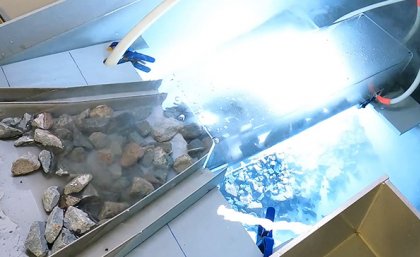
Zapping rocks with a high-voltage pulse – similar to a lightning strike – could be the answer to decarbonising the mining industry according to researchers from The University of Queensland.
Researchers from UQ’s Sustainable Minerals Institute have developed High Voltage Pulse (HVP) technology, which uses a short-pulsed discharge similar to a lightning strike, to selectively break mineralised ores while keeping barren rocks intact.
Project leader Dr Christian Antonio said their HVP technology, in the process of being commercialised, could significantly reduce energy consumption and essentially help decarbonise the mining industry.
“Mineral processing is the most energy intensive part of mining and is a significant consumer of energy globally,” Dr Antonio said.
“This technology makes it possible to choose the material which should go to the processing plant and leave behind material which contains little or no metal.
“By separating ‘barren’ rocks from the valuable mineralised rocks, which are weakened by the lightning strikes, we can cut down processing time and make the whole process more energy efficient.
“These efficiencies are noticeable throughout the mining process but, in the grinding stage in particular, our research has shown a reduction of approximately 30 per cent in processing time and energy consumption.”
Dr Antonio said the concept behind HVP technology was similar to lightning attractors – or how lightning was more likely to strike someone holding a metallic umbrella.
“Electrical energy automatically targets the conductive mineral particles within a rock and breaks up the rock as it makes its way to them,” he said.
“To deliver this energy we also electrify a conventional piece of mineral processing equipment that sorts rocks by size, meaning we are simultaneously zapping the rocks and sorting the fragments.
“This is a more efficient way to deliver the energy while achieving the over one hundred tonne per hour throughputs required by the mining industry.”
HVP technology is one of the main focuses of UQ’s Julius Kruttschnitt Mineral Research Centre’s Separation Group, which develops mineral separation processes that improve profitability and minimise environmental impact.
Group Leader Associate Professor Kym Runge said there was wide industry interest in how the technology could decarbonise operations.
“A key part of this project is showing our partners that the technology can feasibly be added to their plants,” Associate Professor Runge said.
“We are currently working on building a business case that will quantify the benefits of this technology, then we will design a HVP unit integrating our technology and progress that to commercialisation.
“Ultimately the plan is to build a pilot plant and demonstrate the benefits of HVP at one of our sponsor’s sites.”
This research is funded through the Resources Technology and Critical Minerals Trailblazer program, which also has the support of several mining industry partners, including Newmont and JKTech.
Media contacts
Dr Christian Antonio
+61 451 512 577
Associate Professor Kym Runge
+61 418 950 043
Sustainable Minerals Institute Media
+61 447 812 081
.jpg)








